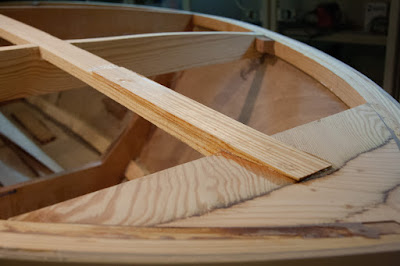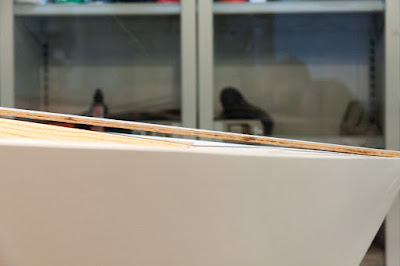Todays blog post is about assembling the stem for my Glen-L Zip. The Zips stem, as with many Glen-L designs, is made from two identically shaped pieces of 3/4" marine-grade plywood, laminated together with marine epoxy and fastened with silicon bronze screws.
This is now the third stem Ive built; the other two being for a Squirt and a Utility. Learning from previous experience, I did a few things differently this time.
First, I spent much more time and care in shaping the pieces beforehand. I feel very comfortable this time around with the shape being correct.
Second, I used less epoxy. The other two times, I globbed a bunch of thickened epoxy on, just to make certain there was enough. In reality, that just creates more of a mess, because the majority of it squeezes out.
Third, I kept a putty knife ready to scrape away the epoxy that squeezed out from between the two layers of plywood. This makes for much less sanding afterwards.
Also, having learned a tip from a fellow boatbuilder, I used an awl to quickly align the pre-drilled holes before driving the screws back in. This proved to be a great time-saver, since it can be a little tricky to mate the holes back together with epoxy spread over the wood, (particularly while wearing latex gloves, goggles, and a respirator).
For the epoxy, I used Glen-L Poxy Shield, thickened slightly with #2 silica. Poxy-shield is mixed in a 5:1 ratio, using 5 parts resin to 1 part hardener. It can be hard to find very small mixing cups in order to measure small batches of epoxy, so Ive used my own method. I take a regular off-the-shelf mixing cup, and measure the distance between the pre-printed volume marks. So far, all the cups Ive used had a distance of 8mm between the 4oz and 8oz markings. So, I add marks every 2mm between them to show the 5oz, 6oz and 7oz lines. That way, I can pour in 5oz of resin, then add hardener until the mixture reaches the 6oz line. There are, no doubt, more accurate ways to go about this. However, this way is quick, simple, cheap, and effective.
 |
| Perhaps not the most scientific method, but it works. |
After mixing and thickening the epoxy, I spread it out on the mating surfaces of each stem piece, making sure the whole area was covered. Then, I put the pieces together & aligned a couple of holes with the awl. I dipped the silicon bronze screws in a little epoxy, then drove them down into the holes. Then, I clamped the pieces together solidly, driving the screws in further as needed. Afterwards, I scraped away the epoxy that had squeezed out from between the layers before the epoxy became unworkable. Then I left it alone to let the epoxy cure overnight.
 |
| Everything ready to go: Stem parts, Poxy-Shield resin and hardener, #2 silica, mixing cups, mixing stick, chip brush, awl, screwdriver, extra screws (just in case), clamps, and putty knife. |
 |
| Glued, screwed, clamped and scraped with the epoxy curing. |
On a final note, I also worked on the Utility over the weekend... still fairing. It seems like a never-ending process, but its getting there.



























































